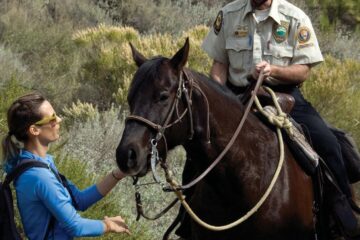Eager crowds are flattening Southern California’s vibrant ‘super bloom’
If it’s not drought that’s keeping the flowers down, it’s the visitors
Source of this article: The Los Angeles Times, April 9, 2017
After a record series of winter storms buried the Sierra Nevada in snow and filled rivers and lakes to the brim, a “super bloom” of desert flowers has sprouted in long-parched Southern California and painted the landscape in swaths of bright red, orange, yellow and purple.

Visitors to Lancaster’s Antelope Valley California Poppy Reserve stray off the trail and into the flowers. Park officials say heavy foot traffic has created new paths where grass and blooms once were.
The eruption of flora — perhaps the largest in more than a decade — has drawn a steady stream of eager flower-peepers, including naturalists, tourists and hordes of amateur photographers seeking the perfect trophy shot for their social media accounts.
Unfortunately, this extraordinary bloom has also caused many visitors to stray from established foot paths and sent them tromping through fields of California poppies and other flowers, crushing their delicate petals and stems.
Initially, state and local park managers viewed the spike in visitor traffic as a boon. Now, however, some are finding it a nightmare as they struggle to preserve the ephemeral blooms amid growing crowds.
At Diamond Valley Lake in Riverside County, park officials were forced to close a section of the mile-long wildflower trail because visitors were marching off the path to snap photos.
“We had literally thousands of people a day coming out to visit in a couple weeks. We’ve never seen it this busy,” said Wendy Picht, a senior environmental specialist with the Metropolitan Water District, which manages Diamond Valley Lake in Riverside County. “But at the same time, it was a little bit too much.”
The trail, opened Feb. 24, drew a trickle of visitors at first. But that rapidly grew as word spread of what this year’s historic rainfall had wrought. By March 29, operators ordered the trail closed because of wildflower losses.
The trail was reopened Wednesday — a week later. This time, however, signs were posted in four languages warning hikers to stay on the footpath, and volunteers were stationed along the trail to guide people.
The poppy fields draw the most eyes, Picht said. The flowers last the longest and are brighter than other area species, such as baby blue eyes, arroyo lupine, caterpillar phacelia and Canterbury bells.
“It happened sort of suddenly, people started disregarding the rules and trail guides,” Picht said. “You can’t really blame them, but at the same time, we couldn’t allow that.”
Her concerns were echoed in the high desert, where throngs of visitors have trekked to the California Poppy Reserve to get the best photographs, an employee said.
A search on Instagram for “#superbloom” turns up more than 50,000 results with recent photos coming from local and state-run parks.
Some photos show visitors holding plucked bouquets of wildflowers, while others show them striking poses within the blooms.
“Spent 3 hours in the car to take pictures for 30 minutes,” one woman wrote on Instagram. The post included an image of her sitting in a bed of poppies.
“’Bloom where you’re planted” wrote a man who was photographed lying on his back with crushed petals next to his head.
Lancaster’s massive field of golden flowers has been popular on social media in recent weeks, and the effects are starting to show.
At least two new “paths” have emerged at the reserve from people’s continuous steps, and workers have had to add signs telling visitors to stay on the trail and to watch out for wildlife, a park employee said.
Meanwhile, at Walker Canyon in Lake Elsinore, visitors have turned dusty highway shoulders into improvised parking lots. The area has few trails but offers plenty of flower-covered hillsides to amble through.
“We even had folks parking on the freeway,” Lake Elsinore city spokeswoman Nicole Dailey said. “The land abuts the 15 Freeway so they’re taking it upon themselves to pull over to the shoulder.”
Commuters have reported hour-long traffic jams because of the cars exiting into the canyon, she said.
A wave of visitors to Anza-Borrego State Park in San Diego brought similar issues last month, said Kathy Dice, the park’s superintendent.
“This was the first super bloom where we experienced the power of social media and the Internet,” Dice said. “This really drove our numbers beyond anything.”
At the peak of the rush, some guests parked their cars on the side of the road or private property and left trash behind, she said.
“That was the downside of the flower bloom,” she lamented. “The vast majority of people were great, but there are people who don’t behave properly.”
But not every park with a super bloom has shared the fate of those in Southern California.
At the Carrizo Plain National Monument in the Central Valley, a record number of visitors swarmed the park over the last month to see the best bloom in recent memory — but they also managed to behave, said Serena Baker, a spokeswoman for the federal Bureau of Land Management.
The visitor center had more than double its average guests over the weekend, and drivers eager to see the flowers filled the parking lot or stopped on side of the road leading into it, Baker said.
Despite the crowd sizes, people have been courteous and respectful, she said.
“People have been really good; we’re really proud of them,” she said.





1 Comment
Steve · April 9, 2017 at 11:22 am
You can see many more photos of the spectacular wildflower show at the Carrizo Plain National Monument here: http://www.venturacountytrails.org/Trips/CA-OR-WA/2017-03CarrizoPlain/_Page.html